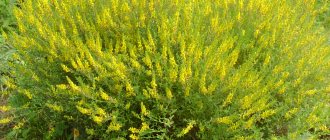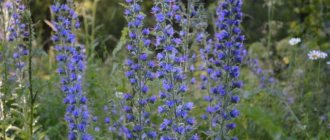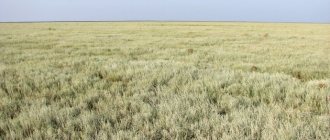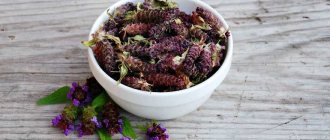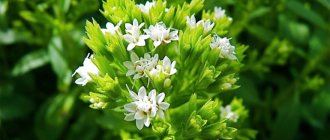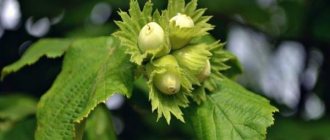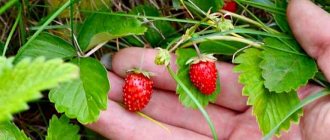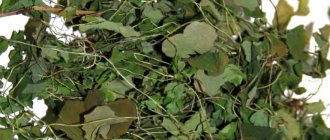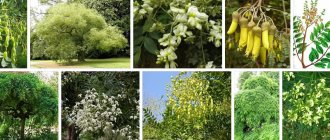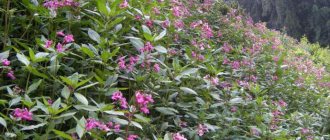The medicinal properties and contraindications for toadflax are determined by its unique chemical composition. This is a perennial herbaceous plant from the Plantain family, distributed throughout Eurasia. It usually grows in abandoned fields, meadows, and gardens. People call it:
- wild or female flax;
- gills, rams;
- dogs;
- chistik, flax of the Virgin Mary.
When fresh, common flax has pronounced insecticidal properties.
Chemical composition of toadflax
Common toadflax contains the following substances and elements:
- the alkaloid peganine, which normalizes blood pressure and heart rate, increases the tone of the smooth muscles of the intestines and uterus;
- organic acids - malic, acetic, formic, citric - they have antimicrobial and antioxidant properties, improve metabolism;
- saponins and pectins;
- vitamin C, which improves immunity, carotene;
- flavone glycosides (linamarin, pectorinarin) increase vascular elasticity;
- tannins, vegetable oils.
Seeds of female flax consist of 35% fatty oils.
Attention! According to research conducted in 2012, toadflax is a natural transgenic plant, like tobacco and sweet potatoes, containing genes from the bacterium Agrobacterium rhizogenes.
Common female flax grows as a weed in Russia and is sometimes used by gardeners in landscape design
Common toadflax: description
- herbaceous, perennial plant;
- leaves are smooth but sharp;
- yellow flowers;
- minimum height - 30 cm;
- maximum height - about 60 cm;
- the stem is straight, on which only a few branches grow;
- fruits are oblong capsules with winged seeds;
- flowering period - summer months;
- has poisonous properties;
- has an unpleasant odor.
It is in meadows and sandy river banks, wastelands and forest edges, and near roads that common toadflax grows. The family to which the plant belongs is called Norichaceae.
The healing composition of toadflax herb is distinguished by the following beneficial substances:
- alkaloid peganine;
- flavonoid glycosides;
- ascorbic acid;
- tannins;
- phytosterol;
- carotene;
- saponins;
- minerals;
- pectins;
- resins;
- mucus;
- organic acids.
Flaxseeds contain about 35% fatty oil. During the hydrolysis process, glycosides release paraffins and hydrocyanic acid.
Useful properties of toadflax
Decoctions, infusions and ointments based on the toadflax herb have a powerful effect on the human body:
- anti-inflammatory, analgesic and antimicrobial;
- laxative, diuretic, reducing the formation of gases in the intestines;
- antioxidant and anticancer;
- choleretic, restorative and tonic;
- antipyretic, diaphoretic, removing waste and toxins from the body;
- antihistamine and expectorant;
- reducing pressure;
- normalizing the functioning of the gastrointestinal tract and metabolism.
Important! Before using preparations based on toadflax, you should consult your doctor.
Common toadflax: application, photo, description
Common toadflax is a plant that is not used at all in official medicine, but is actively used by healers and herbalists.
It turns out that this herb has multiple beneficial properties: it actively helps with digestive problems, treats many skin diseases, and is effective in the treatment of urolithiasis and gallstone diseases. And what’s interesting is that, being a poisonous plant, toadflax has an antidote effect. Alternative medicine offers recipes for many tinctures, ointments, decoctions and lotions based on the above plant.
Finding this grass is not a problem, because it grows almost everywhere: near roads, in fields, motherworts, and weeds gardens.
Harm of toadflax
Common toadflax is far from a harmless plant. The presence of alkaloids and glycosides in its composition makes the plant poisonous to humans and domestic animals. The main symptoms of poisoning by this perennial are as follows:
- dizziness and decreased blood pressure, fainting;
- severe cutting pain in the abdomen, diarrhea;
- excessive salivation;
- nausea, vomiting.
When taking preparations from female flax orally, you should carefully monitor the body’s reaction. If negative symptoms appear, the course must be stopped immediately.
Contraindications to flaxseed
Flaxseed, like other plants, has a number of restrictions on its use:
- individual intolerance, expressed by allergic reactions - swelling, itching, rash;
- periods of pregnancy and breastfeeding;
- children under 14 years of age;
- high blood pressure;
- liver cirrhosis, renal failure.
Persons suffering from tachycardia can also cause significant harm to their health when taking this drug.
Contraindications
Before using flaxseed, you should familiarize yourself with the contraindications. It should not be used for the following diseases and conditions:
- pregnancy (the grass can create a risk of miscarriage or premature birth);
- breast-feeding;
- children under 3 years of age;
- severe hypertension;
- severe cardiovascular diseases;
- allergic reaction to the plant.
Flaxseed can be purchased at a pharmacy or you can prepare it yourself by cutting off the above-ground parts of the grass and drying them. The plant should be stored in a closed jar for no longer than 1 year. Decoctions, infusions, and ointments made from it show effectiveness in diseases of the heart and blood vessels, stomach, kidneys and liver, and skin. However, they should be used as a complement to treatment prescribed by a doctor, and not instead of it.
The grass with such an affectionate name, toadflax, is classified as a poisonous plant (which it warns about in advance with an unpleasant odor). And this does not go well with its beautiful flowers, which even decorate front gardens and gardens. The flowers are yellow with a peculiar shape, which prompted the idea to call them dogs and even snapdragons. Like many poisons, in a certain dose, the toadflax plant is a medicine. It is used, however, to a greater extent in alternative medicine, but official medicine has also begun to show interest in this plant.
In any case, research in this direction is being carried out. For example, Professor M.D. Russian, through experiments, showed that flaxseed (more precisely, its extract) acts as a mild laxative in patients with decreased intestinal tone, which is accompanied by bloating and constipation.
German doctors also use toadflax in the form of a water infusion for intestinal sluggishness, in addition, for cystitis and hemorrhoids. In homeopathy it is present somewhat more widely. The essence is used to treat the liver, edema of various origins, and menstrual cycle disorders.
Flaxgrass is a perennial plant with smooth, sharp leaves located on a straight stem with only a few branches. Can grow up to 60 cm tall. Feels comfortable on roads, in vacant lots, and in the forest at the edges. Meadows and sandy river banks are also the habitat of this plant. The winged seeds leave the fruit capsules in summer. The plant is very unpretentious, requiring watering only during periods of severe drought.
A little history
It’s unlikely that anyone will say when toadflax was born, but it is known for certain that they began to heal with it in ancient times. Healers used poultices from the leaves of the plant to treat inflammation of the eyes, the pursued goal being to relieve tearfulness. They healed ulcers by achieving the formation of scar tissue, using an ointment prepared by mixing dry powder and lard. In addition to this, they drank herbal juice all day.
Flaxseed in powder form was used as a powder on the sites of burns, purulent fistulas, and ulcers. Bloody diarrhea was cured with the juices of flaxseed and plantain herbs, mixed in equal proportions. It remains only unknown in what quantity this drink was offered.
It was taken on faith that if you enjoy the herbal juice of toadflax when the stars in the sky line up in a certain order, then the bites of various poisonous reptiles will not pose a danger to a person for a whole year.
Beneficial features
Why do healers like common toadflax today? Because its juice is simply filled with useful substances.
Flaxseed is rich in:
- fatty oils;
- carotene, which turns into vitamin A, increases the effect of sex hormones, improves the healing of wounds and burns, and has many other beneficial properties;
- choline, which successfully helps with depression and protects nerve cells from damage;
- malic, citric, ascorbic acid;
- tannins that have bactericidal, anti-inflammatory, hemostatic effects;
- alkaloids that act on the nervous system as a sedative, antitussive, and analgesic. They also restore heart rhythm and lower blood pressure.
This composition of the herb provides a variety of therapeutic effects. Traditional healers use toadflax to treat anemia (anemia). With its help, metabolic disorders in the body are improved. Flaxseed has an expectorant effect, especially when mucous sputum is difficult to clear. The ability of toadflax to expel stones and sand from the bladder is used; it also helps cleanse the gastrointestinal tract, thereby performing a detoxification function in case of poisoning.
Flaxseed is widely used to strengthen the body's defenses and has a remarkable anti-inflammatory effect. Helps men with potency and improves menstruation for women. Flaxseed relieves shortness of breath and is beneficial for swelling, diathesis and inflammation of the bladder. Facilitates the condition of a patient with jaundice, soothes pain due to hernias. It is used by knowledgeable herbalists in the treatment of myopathy, an inherited disease accompanied by muscle weakness. Flaxseed is effective for paresis and paralysis of the limbs.
Flaxseed relieves dizziness and sore throat. Since the herb has antiseptic properties, it can be used to treat conjunctivitis and inflammation of the nasopharynx. Thanks to this plant, patients get rid of boils and purulent wounds. Urinary incontinence, gastric ulcers, hemorrhoids, and helminthic infestations can be treated with this plant. And this is not a complete list.
Harvesting grass
Flaxseed for the preparation of medicinal forms is harvested in the summer months in dry sunny weather, during flowering. The collected raw materials are dried, as a rule, on the street or in a well-ventilated room, but in both cases, always in a shaded place, spread out in thin layers.
The raw materials, packaged in several bags and placed in wooden boxes lined with paper, will not lose their healing qualities all year round. For treatment, flaxseed is in most cases used in the form of decoctions, tinctures, and ointments; patients also take baths and use lotions.
Folk recipes
Ointment for skin lesions
The herb is thoroughly crushed, then infused with 70% alcohol for 24 hours in the proportion: 2 parts herb and 1 part alcohol. After this, 10 parts lard is added to the resulting solution, and the mixture is placed in a water bath. The ointment will be ready when all the alcohol has evaporated.
Infusion for affected skin (purulent wounds and ulcers)
Six tablespoons of flaxseed should be poured with one glass of boiling water just removed from the heat. The solution should sit for two hours, after which it is filtered. Now they can wash the affected areas of the skin or use them as lotions. All this is done twice a day until the wounds heal.
Constipation tincture
The tincture is prepared with vodka, one glass of which is filled with one identical glass of toadflax herb. Leave for several hours and take one teaspoon before going to bed.
Remedy for hypotension (low blood pressure)
The tincture is prepared from 50 grams of dried toadflax and 500 milliliters of vodka. Shaking occasionally, leave for two weeks, longer if possible. Be sure to take only 20 drops three times before meals. Important: do not increase the indicated dose under any circumstances!
Eye treatment
The following medicine contains not only flaxseed, but also other plants. A collection is prepared, which includes wild flax (dried), elderberry and blue cornflower flowers - the plants are taken by weight in equal parts, 20 grams each. All components are mixed and placed in a thermos filled with 400 milliliters of boiling water. The future medicine is infused for eight hours. This infusion is then filtered. Now you can wash your eyes with it or apply it as a lotion 4 to 5 times a day. And this is done until complete healing.
Or leave one tablespoon of dry herb in five hundred milliliters of boiling water for three hours. After filtering, you can rinse your eyes with warm solution or use lotions.
We treat the liver and genitourinary system
To prepare the medicine you will need toadflax, corn silk and immortelle flowers. All of them are taken equally and mixed thoroughly. Now take one and a half small spoons of this mixture and pour 250 milliliters of boiling water. Leave for one hour and strain. Healers recommend taking this remedy one tablespoon before breakfast, lunch and dinner. The course of treatment is two weeks.
Remedy for hemorrhoids
Ingredients: flaxseed and unsalted lard. Mix two parts of dry raw materials and five parts of lard, heat, squeeze out the grass, and strain the lard. Apply the resulting green ointment to the hemorrhoids.
Reliable recipe for constipation
We prepare the medicine from 100 grams of fresh toadflax herb and 0.5 liters of sunflower seed oil. Leave to infuse for a week in a shaded, warm place. The container needs to be shaken periodically. Strain after 7 days. Take in dose: a tablespoon half an hour before meals.
Common toadflax for cancer
A dessert spoon of toadflax herb is crushed and poured with 250 milliliters of boiling water. Steam in a water bath for fifteen minutes. The solution should infuse for the next 45 minutes. Then we strain it. It is recommended to drink a tablespoon of medicine before meals thirty minutes three times a day.
If the tumor is external, in parallel with taking the medicine, we apply lotions from the same solution to it.
Flaxseed for inflammation
The medicine is prepared from four tablespoons of the herb, boiled in 500 ml of milk. When the gruel has cooled to a “warm” state, make a compress with it on the inflamed area of the skin.
Flaxseed for dystrophy
Pour dry raw materials (ten parts) with two parts of vodka. Shaking occasionally, leave for three weeks. Then strain the solution and squeeze out the herb. The recommended dose consists of forty drops of tincture, washed down with water (half a glass) before meals three times a day.
Interestingly, toadflax also exists under many other names. For example, jaundice, gills, nemitsa, flax, lunets, hatchets and others.
In everyday life, toadflax is used for household needs; with its help, insects are destroyed in animal stalls. But it is also poisonous to the animals themselves. Poisoning of cattle and horses will manifest itself as excessive salivation, respiratory distress in the form of shortness of breath, weakening of the heart muscle, and diarrhea.
Contraindications
Under no circumstances should you self-medicate using this plant, only after consultation with a specialist. And you need to understand that flaxseed can only be recommended as an additional treatment prescribed by a doctor, and not instead of it. Nevertheless, it won’t hurt to familiarize yourself with the contraindications.
Naturally, if you have an allergic reaction upon contact with toadflax, even just in the form of a rash, there is no need to talk about treatment with this herb.
Toadflax remains strictly prohibited for women during pregnancy and for mothers breastfeeding.
It is prohibited for persons with severe hypertension and those suffering from cardiovascular diseases to be treated with flaxseed.
Children under three years of age are protected from such treatment.
It has already been said above that toadflax is a poisonous herb, so when using it as a medicine, various complications can be expected. They occur when you deviate from the rules for preparing the drug and when the dosage is exceeded. Most often, side effects will manifest as severe salivation (salivation), vomiting and heart failure.
In addition, if the drug is overdose, you can get severe dizziness and even fainting. The appearance of sharp abdominal pain will lead to an incorrect diagnosis when examined by a doctor, which will affect further treatment. Severe diarrhea is possible, accompanied by cramping pain in the intestines. Flaxseed causes complications from the cardiovascular system in the form of heart rhythm disturbances such as paroxysmal tachycardia and extrasystole.
This is why it is so necessary to first consult a doctor and limit the course of treatment, as experts advise, to ten days.
Content:
Toadflax , also known as snapdragon, female flax, gill flax, wild flax, shoewort, lungwort, and so on, is a perennial plant of the plantain family, widespread in almost all regions of Russia. The habitat of this plant is dry meadows, forest edges and roadsides. The height of the plant ranges from 30 to 90 cm depending on the species. Flowering in different species lasts from June to August. The toadflax family includes more than 100 plant species, 18 of which are included in the lists of rare species in Europe.
Officially, toadflax is not used in traditional medicine, but its pronounced therapeutic effect has allowed it to gain great popularity in folk medicine. It is also known for certain that in a number of countries doctors prescribe flaxseed preparations to their patients. For example, in Germany for jaundice, inflammation of the bladder and constipation, in Korea - as a sedative, and in Mongolia - for bites of dogs and other animals.
Rules for using flaxseed
When deciding to use toadflax, you must remember that it is not officially registered as a medicine. Traditional medicine recommends adhering to the following rules when consuming it:
- dried stems, leaves and flowers of female flax should be free of foreign impurities and odors, bitter-salty taste;
- the course of treatment is no more than 10 days, if repeated treatment is necessary, take a break of 2 weeks;
- juice as an anthelmintic is taken before bed, on an empty stomach, 20 ml;
- an oil infusion of the herb with the addition of hot pepper is an excellent external remedy for joint pain, for rubbing the chest and back for bronchitis;
We recommend reading: Chili peppers: benefits and harms, properties, how to eat them
- ointment made from animal fat and crushed blenny is effective for skin problems, lichen, eczema;
- alcohol infusion can be used for acne, as well as 10-20 drops orally before meals;
- A decoction of the plant can be consumed 2-4 times a day, a dessert spoon.
We recommend reading: Benefits of bell pepper, properties
When heat treated, toadflax does not lose its healing properties, so it can be infused in boiling water, boiled and simmered in a water bath.
Important! Common toadflax is a poisonous plant, so you must carefully observe the dosage and follow the preparation recipes.
Dry raw materials for preparing infusions and decoctions can be bought in pharmacies and markets
Use in folk medicine
Although toadflax is not used in official medicine, it is a subject for scientific research. It has been experimentally proven that the plant extract has a mild laxative effect on patients suffering from long-term chronic constipation and flatulence.
In pharmacies you can buy dried and packaged flaxseed herb and an ointment based on flaxseed extract. But these drugs are classified as phytotherapeutic.
In alternative medicine, teas, decoctions, tinctures, extracts and extracts are prepared from wild flax. Based on the extract, healing ointments are made for external use.
For an aqueous infusion of dried herbs, you need to pour 1 teaspoon of crushed raw materials into a thermos, pour a glass of boiling water and leave for a quarter of an hour. Strain and drink in 3 doses per day for:
- disruption of the gastrointestinal tract: stomach pain, constipation and intestinal obstruction, atony or weakness of the intestines (especially in the postoperative period);
- swelling;
- liver dysfunction;
- carbohydrate metabolism disorders;
- bedwetting;
- migraine;
- dizziness with vomiting;
- worms;
- anemia;
- long-term cough (as an expectorant and phlegm remover).
For flatulence, it is recommended to dilute the resulting infusion with warm water in a ratio of 1:2 and drink it throughout the day, like tea.
A condensed infusion of flaxseed is prescribed for constipation. To obtain it, the herb infused in a thermos must be poured into a porcelain container and evaporated to a third of the volume in a water bath. Take before bedtime. The taste of the brewed potion is sharp, bitter and astringent. A decoction of wild flax seeds also helps with constipation.
To prepare a healing ointment, you need to take 2 parts of dried flaxseed and 5 parts of vegetable oil (olive, flaxseed, sesame, corn) or 3 parts of animal fat (badger, lard, glycerin). Mix everything and heat over low heat for 10-15 minutes. Strain, pour into a glass jar with a tight lid and let cool.
Use as an ointment and for compresses for hemorrhoids and rectal fissures, varicose veins, and skin irritations. For hemorrhoids, it is recommended to combine external use of the ointment with microenemas with infusion and oral decoctions. Additionally:
- An infusion of flowers is prescribed for compresses for eye diseases and conjunctivitis.
- An aqueous infusion of fresh herbs and flowers is prescribed as a gargle for sore throat, throat diseases, stomatitis, and fungal infections of the oral mucosa. Externally, this infusion is used in the form of compresses to relieve itching in psoriasis, rashes, eczema, and also as a painkiller for bruises. For bruises, joint pain, rheumatism and gout, compresses with a decoction of the flowers of the oleaster plant are prescribed.
- A decoction of crushed herbs in milk helps with acne, lichen, and boils. In order for the boil to ripen faster, it is recommended to wrap the warm boiled herb in several layers of bandage and apply it to the site of the abscess. To quickly heal wounds and burns, a decoction of lofant flowers is often prescribed.
- Fresh juice helps remove worms and their waste products from the body. For treatment, take fresh wild flax herb, wash, squeeze and grind in a meat grinder (it is better to use a manual one, not an electric one). Squeeze the resulting pulp, dilute the juice with water in a 1:1 ratio and drink a tablespoon before bed.
- Due to the high concentration of vitamins, wild flax decoction is prescribed as a tonic or restorative drug. Taking a decoction helps the body fight infections, especially during the flu-like winter period.
- An alcoholic tincture of wild flax is prescribed as a sedative (calming agent). To make it, you need to take 2 parts of crushed dry grass and 1 part of pure alcohol, mix in a glass container and leave in a dark place for 24 hours. Before going to bed, dilute 2-3 drops of tincture in a spoon of water and drink.
- A warming ointment is prepared based on alcohol tincture. To do this, take 1 part of the finished tincture and 10 parts of lard. Melt the lard in a water bath, pour in the tincture, stir (the alcohol will evaporate). Allow the ointment to cool and rub on sore joints before going to bed. Store in the refrigerator for 3-4 months.
Considering the fact that the plant is poisonous, the first course of taking the drugs does not exceed 1 week. Next, the doctor examines the patient and, if the dynamics of treatment are positive, prescribes the next course.
Application of toadflax
The medicinal properties of toadflax have been little studied by official medicine. Only its mild laxative effect, which does not irritate the intestines, as well as choleretic and diuretic properties have been proven. In Germany, water infusions are prescribed for jaundice, inflammation of the urinary system and hemorrhoids. In East Asia, toadflax preparations are used as a mild sedative for wild animal bites and bedwetting.
In folk medicine, toadflax is used for the following problems:
- poisoning and metabolic disorders;
- conjunctivitis, fungal infections of the skin;
- dizziness, anemia, flatulence;
- colds, hepatitis, tonsillitis;
- cystitis, cycle disorders in women;
- chronic constipation and eczema;
- Meniere's syndrome and furunculosis.
Decoctions and infusions of this healing plant successfully prevent hair loss and improve potency in men.
Common toadflax (Linaria vulgaris Mill.)
Syn.: shark, rams, shoegrass, runner, budra, vidalnik, gladovnik, throat grass, grimon, divina, dolopernik, cucumber spirit, gill grass, toads, gills, jaundice, jaundice, bend, lightning, calls, bells, hare's blood, cowshed, cow's butter, kudrinets, cuckoo's tears, wild flax, flax, lenovnik, lenok, flax grass, flax grass, flax grass, lyunets, honey cakes, medunka, milkweed, fly agaric, nemitsa, nutrennik, borage, ostudnik, pickles, poskrynnik, traveler, consumable, saffron milk cap, hazel grouse, serpium, sickle-cut, fortybur, estate, hundred-headed, axes, guillemot, husk, clear-headed, women's flax, shoemaker, etc.
Article on the topic: Onion - useful properties, description
A perennial herbaceous plant that grows everywhere. Shows pronounced medicinal effects (laxative, stimulant, choleretic, anthelmintic, detoxifying, etc.). It has good honey-bearing and decorative qualities.
Table of contents
In medicine
Common toadflax is not used in official medicine, but its pronounced medicinal properties are of interest for scientific medicine. Experimentally (Prof. M. D. Rossiysky) it was established that toadflax extract acts as a mild laxative on patients with intestinal atony, bloating, prolonged constipation, and peganin (isolated from the plant by him) in turn has a positive therapeutic effect in muscular dystrophy and myopathies. Doctors in Germany prescribe a water infusion of toadflax for jaundice, inflammation of the bladder, constipation, intestinal sluggishness and hemorrhoids. Alcoholic extract of toadflax is used as a sedative in Korea. In Mongolia, toadflax preparations are used for ascites, dog bites, wild animal bites, and joint diseases. In small quantities, toadflax is used for headaches with vomiting (Meniere's syndrome) and bedwetting. Increased urination is observed in the next 2 days after stopping the medication.
In homeopathy, an essence is prepared from the toadflax herb, which is recommended for diseases of the liver, gall bladder, edema of the heart and kidneys, hemorrhoids, menstrual irregularities, chronic constipation, flatulence, postoperative atony of the intestines and bladder.
Contraindications and side effects
Common toadflax is one of the poisonous plants and when used for medicinal purposes, its toxicity should be taken into account. Therefore, prolonged use (especially orally) of drugs based on it requires caution and strict adherence to dosage in order to avoid side effects (nausea, vomiting, severe drooling, heart failure, severe dizziness, headache, severe abdominal pain, upset stomach and even fainting), poisoning . The use of toadflax is contraindicated for children, women during pregnancy and breastfeeding, patients with liver cirrhosis, renal and hepatic dysfunction, paroxysmal tachycardia and extrasystole. The course of treatment and individual dosage of toadflax consumption should be determined by a specialist.
In other areas
Common toadflax is also of economic importance; it is used to kill insects in animal houses.
Classification
Common toadflax (Latin Linaria vulgaris) is a species of the genus Linaria of the family Scrophulariaceae. The genus includes about 150 species of herbaceous plants growing in extratropical regions of the Northern Hemisphere, mainly in the Mediterranean. Of these, 60 species are found in the Caucasus and Central Asian countries.
Some species of toadflax are endemic (for example, the pyramidal toadflax (lat. L. pyramidata) is endemic to Armenia). The list of rare species of Europe already includes 18 species of toadflax, including 5 Portuguese and 8 Spanish. In Russia, a number of species of the genus already have a protected status and are in the regional Red Books: Altai toadflax (lat. Linaria altaica) - in the Red Book of the Republic of Bashkortostan; Bieberstein's toadflax (lat. Linaria biebersteinii) - in the Red Book of the Lipetsk region; fragrant toadflax (lat. Linaria odora) - in the Red Book of the Saratov region; Cretaceous toadflax (lat. Linaria cretacea) - in the Red Book of the Rostov and Saratov regions, Kazakhstan and Ukraine.
Botanical description
A perennial herbaceous plant with a height of 30-60 or more (90) cm. The root system is taproot. Has long creeping shoots. Stems are branched, densely leafy. The leaves are numerous, alternate, sessile, without stipules. The leaf blade is entire, glabrous, lanceolate-linear, narrowed towards the base. The flowers are bisexual, zygomorphic (irregular), collected in dense long racemes. The bracts are lanceolate, usually longer than the pedicels. The inflorescence axis, peduncle and calyx are glandular-pubescent. The perianth is double, 5-membered. The calyx is fused-leaved (about 3 mm in length), dissected to the base, with lanceolate, thinly pointed lobes. The corolla is fused-petalled, two-lipped, with a spur (20-30 mm long) and a closed throat, whitish-yellow, with a bright orange spot on the convex part of the lower lip. There are 4 stamens, 2 of which are longer. The filaments are attached to the corolla tube. The ovary is superior, of 2 carpels, 2-locular, with a large number of ovules. The fruit is a capsule. The seeds are numerous (about 32 thousand) with a membranous edge for easier dissemination by the wind. Propagated by seeds and root suckers. It blooms for quite a long time (June-September). It begins to bear fruit in August.
Spreading
Common toadflax is found almost everywhere in Russia. Prefers dry meadows, fields, disturbed forests, roadsides, railway embankments, forest clearings and edges. As an alien and weed plant, it is often found in non-traditional habitats, for example, as a common weed in forage grass crops. It is bred (like other species of the genus) as an ornamental plant.
Procurement of raw materials
The herb is used for medicinal purposes. Raw materials are harvested during flowering from June to August. Cut off the entire above-ground part of the plant in dry sunny weather at a distance of about 6 cm from the ground. The raw materials are laid out in a thin layer (3-5 cm) on a clean mat and dried outdoors in the shade under a canopy or in a room with good ventilation. Finished raw materials are stored in thick cotton bags or wooden boxes lined with paper. The taste of the finished raw material is sharp, salty-bitter, shelf life is 1-2 years.
Chemical composition
The basis of the chemical composition of toadflax is: alkaloid peganin, flavonoid glycosides (acetylpectolinarin and linarin, linarizine, neolinarin, pectolinarin). In addition, the following have been isolated from toadflax grass: phytosterols, triacanthin, organic acids (citric, formic, folic, malic and acetic), saponins, pectin and tannins, vitamin C, carotene. Flax seeds contain about 32-35% fatty oil. Glycosides upon hydrolysis release paraffins and hydrocyanic acid.
Related article: Mexican rubber tree - beneficial properties, description
Pharmacological properties
The pharmacological properties of toadflax are determined by its chemical composition. Preparations of toadflax (extract, essence) exhibit many medicinal effects: astringent, anti-inflammatory, detoxifying diaphoretic, analgesic, antiseptic, choleretic, anthelmintic, diuretic, laxative (lung), cleansing, expectorant and restorative. The alkaloid peganine lowers blood pressure, improves pulse and normalizes contraction of the heart muscles, increases the tone of the uterus and intestines, regulates the activity of the gastrointestinal tract, and normalizes metabolism.
Use in folk medicine
The healing properties of toadflax have been widely used in folk medicine in many countries for a long time. In folk medicine, a decoction, infusion, tincture and even tea from the toadflax herb is used with a positive effect for shortness of breath, dropsy, headache, dizziness (accompanied by vomiting), for diseases of the bladder and bedwetting, hemorrhoids, diathesis, anemia, cystitis, urolithiasis disease, ascariasis, the initial stages of prostate hypertrophy, as well as for the treatment of gout (for greater effectiveness, toadflax is mixed in equal proportions with knotweed). For hemorrhoids, toadflax preparations are taken orally, but more often externally, especially for hemorrhoidal cones. In addition, for hemorrhoids, an infusion of flax grass is prescribed at night in the form of a microenema. A decoction of toadflax herb in milk is used as a compress on hemorrhoids. An infusion of the toadflax herb is very useful for constipation and bloating as a mild laxative, and also for coughs as a good expectorant. A decoction of toadflax seeds is used as a laxative and choleretic agent. An infusion of toadflax is used to improve the functioning of the stomach, especially the intestines, get rid of gases during flatulence, increase the secretion of bile, urine, sweat, treat inflammatory processes in the respiratory tract, as well as conjunctivitis (for washing sore eyes). In folk medicine, a decoction of the herb is used to gargle with a sore throat; an infusion of the herb in warm water is used to make lotions for fungal diseases, lichen, scrofula and jaundice.
Flaxseed is used in many medicines; for example, in Tibetan medicine, flaxseed is used for swelling of the joints; a compress on the sore joint and an infusion of the herb are recommended. In German folk medicine, toadflax herb is used to treat inflammation of the kidneys, bladder and urinary retention.
Flaxseed is quite widely used in home dermatology and cosmetology in the form of ointments, infusions and decoctions with warm water and milk for washing, rubbing, compresses, lotions, baths and sitz baths (for hemorrhoids, sometimes an ointment made from fresh juice of green grass with lanolin), various skin rashes, fungal diseases, eczema, psoriasis, scrofula, jaundice, wounds, ulcers, lichens, dermatitis, warts, polyps, boils, acne, rashes, ulcers, as well as for washing hair for itching, dandruff, as well as hair loss and for better hair growth.
Historical reference
Flaxseed has been used as a medicinal remedy since ancient times. Ancient healers applied a poultice of flax leaves to sore eyes to stop lacrimation. An ointment made from a mixture of dry flaxseed powder and lard was applied to childhood ulcers for healing and scarring, and the plant juice was given to drink throughout the day. Powder from the flax grass was sprinkled on old ulcers, areas affected by fire, and fistulas with pus. The juice of flax grass and plantain leaves in equal parts was given to drink to a patient suffering from bloody diarrhea.
It was believed that if a person consumes syrup (with a small amount of olive oil) from the toadflax herb when the Sun enters the constellation Aries, then for a year he will not be afraid of poisons from the bite of snakes, scorpions, and will also be freed from all evil (ancient treatise Amirdovlat Amasiatsii). Therefore, the medicine from flaxseed was called “saving, delivering,” which saves from all kinds of poison and protects against it.”
Literature
1. Atlas of medicinal plants of the USSR / Ch. ed. acad. N.V. Tsitsin. M.: Medgiz, 1962. P. 14-16. 702 pp.
2. Belousova L.S., Denisova L.V. Rare plants of the world. M.: Forest industry, 1983. 344 p.
3. Biological encyclopedic dictionary / Ch. ed. M. S. Gilyarov) 2nd ed., corrected. M.: Sov. Encyclopedia. 1989.
4. Gubanov, I. A. et al. 1148. Linaria vulgaris Mill. – Common toadflax // Illustrated guide to plants of Central Russia. In 3 volumes - M.: Scientific T. ed. KMK, Institute of Technology. issl., 2004. T. 3. Angiosperms (dicots: dioecytes). P. 181.
5. Plant life / Ed. A. L. Takhtadzhyan. M.: Enlightenment. 1981. T. 5. Part 2. 425 pp.
6. Elenevsky A.G., M.P. Solovyova, V.N. Tikhomirov // Botany. Systematics of higher or terrestrial plants. M. 2004. 420 p.
7. Kupriyanova L. A. Genus 1328. Toadflax – Linaria // Flora of the USSR. In 30 volumes / Started under the leadership and editor-in-chief of academician. V. L. Komarova; Ed. Tom B.K. Shishkin and E.G. Bobrov. M.-L.: Publishing House of the USSR Academy of Sciences, 1955. T. XXII. pp. 201-202.
8. Nikiforov Yu. V. Altai herbs-healers. Gorno-Altaisk: Yuch-Sumer - Belukha, 1992.
9. Matveeva TV, Bogomaz DI, Pavlova OA, Nester EW, Lutova LA. Horizontal gene transfer from genus agrobacterium to the plant linaria in nature//Mol Plant Microbe Interact. 2012 Dec;25(12):1542-51. doi: 10.1094/MPMI-07-12-0169-R.
10. Shantser I.A. plants of central European Russia (Field Atlas). KMK. M. 2007. 470 p.
Collection and storage rules
For medicinal purposes, toadflax herb should be harvested during the period of abundant flowering. Depending on the climatic conditions of the region, this may be the beginning of summer or August-September.
The collected stems with inflorescences must be sorted, separating rotten, diseased and pest-affected specimens. The raw materials are dried in the open air, in well-ventilated places carefully protected from the sun. It is not recommended to dry the plant indoors: when fresh, it emits an unpleasant odor, which is difficult to remove later.
The herb should be stored in linen bags or closed wooden containers in a dry, ventilated area without access to sunlight. The shelf life of harvested raw materials, subject to all conditions, is 24 months. If there is a foreign smell, mold, or bugs, then the grass is unsuitable for consumption.
Common toadflax should be cut in dry, clear weather.
Types and varieties of toadflax
In nature, there are up to one and a half hundred varieties of toadflax, the bulk of which grow everywhere as weeds. About two dozen of them with numerous varieties and quite decorative hybrids are used in gardening and landscape design.
Common toadflax
The most common species, a relatively tall perennial up to 60 cm (in the wild, usually no higher than 40 cm). The flowers of the original species are painted in pale yellow tones with a darker color on the convex part of the lower lip. The leaves are narrow-linear, small, the stems are thin and branched. Common toadflax is absolutely unpretentious in planting and care, which is why it is often classified as a weed garden plant. The herb has medicinal properties, but is also poisonous.
Cretaceous toadflax
It is a relict variety listed in the Red Book of Rare and Valuable Plants in Ukraine, Kazakhstan and a number of Russian regions. Favorite places of growth are chalk screes, wild steppes, southern mounds of rocky hills open to the sun. Low species up to 30 cm with thin, weakly leafy shoots. The leaves are ovate, small, but fleshy, bluish-green in color. The buds are yellow, collected in a very loose racemose short inflorescence. Decorative varieties can have a variety of colors.
Moroccan toadflax
In European culture, this species is grown as an ornamental annual, since it is not winter-hardy and cannot survive cold winters. Even in the basic line it has a very wide palette of colors and can be variegated. Primary colors are yellow, red-crimson, lilac, violet. The bush is short, 30-35 cm, blooms profusely and for a long time. Despite its higher decorative value, the Moroccan variety is still unpretentious for garden cultivation, with the exception of low frost resistance. Tolerant of slight shade.
Toadflax bifid
A low herbaceous annual no more than 30 cm in height with whorled, pointed leaves. The leaf blade has one pronounced central vein. The corollas of the flowers sit on a peduncle, the length of which exceeds their size, which is why the flower cluster looks loose. The color is light, almost white, with an orange spot in the center of the throat. Flowering is short compared to other varieties, only in the first half of summer. It ends in July with the subsequent formation of a multi-seeded capsule measuring about 4 mm. The homeland of this species is North Africa, but it is also found in the wild in the Central region of Russia, in particular in the Moscow region.
Toadflax
A dwarf variety related to ground cover plants. The maximum height of the bush is 10 cm. The leaves are two-colored, dark green on the outside and green with a purple tint on the underside. The flowers are small, either completely white or light with a purple tint. Flowering is long, throughout the summer and until soil frosts in the fall. Can be grown as a potted plant, popular for decorating borders and edging flower beds. The natural habitat is the entire coast of the Mediterranean Sea, where the dulcimer variety prefers to settle on mountain slopes.
Flaxgrass is a honey plant and is actively visited by bees and bumblebees, although obtaining nectar from its flowers with a complex structure is not so easy.
Photo of toadflax grass
Description of toadflax:
- a very beautiful herbaceous perennial grows up to 40-60 cm;
- has a creeping thin rhizome and a straight stem covered with many elongated leaves;
- At the top, long brushes with many golden-yellow small flowers with an original structure are formed.
The stamens and pistils in flowers are closed by the lower lip, so only large insects, such as bees and bumblebees, can pollinate the honey plant.
Comment! Various types of butterflies readily feast on toadflax.
Common toadflax is often found in abandoned wastelands and overgrown fields
Description of toadflax
Toadflax begins to bloom in early summer, the fruits are ready in the fall. The plant is most often classified as a weed, but can be used for decorative purposes.
There are up to 100 species of toadflax, most often found in mountainous areas in the Northern Hemisphere. Up to 70 plant species grow in Russia, most often they are concentrated in the Caucasus and Central Asia. Usually 8 types of toadflax are popular, the rest can be used as an ornamental plant.
One of the most common species is the common toadflax, popularly known as wild flax, which lives in Western Siberia and Europe. Loves sandy soil, roadsides, edges, slopes and field crops; toadflax is also adapted to dry soil. Therefore, it is often used as a remedy.
